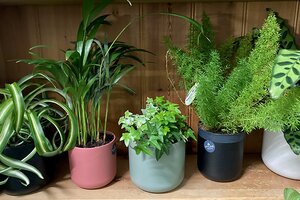Houseplants - Clean Air For Your Home

Indoor air quality matters more than many people realize. From dust and dry air to pollutants like VOCs (volatile organic compounds) released by furniture, paint, and cleaning products, the air inside modern homes can become surprisingly polluted. While houseplants aren’t a replacement for ventilation or air purifiers, they can help filter certain compounds, boost humidity, and create a healthier, more uplifting indoor environment.
Beyond their air-freshening abilities, plants bring psychological benefits too—they calm the mind, increase creativity, and make living spaces feel more restful and alive. Below are some of the best air-purifying houseplants to brighten your home and support your well-being.
Why Houseplants Are Good for You
1. They help freshen the air
Plants naturally absorb carbon dioxide and release oxygen. Some species can also reduce common indoor pollutants such as benzene, formaldehyde, and toluene.
2. They improve humidity
Through a process called transpiration, plants release moisture into the air, helping prevent dryness, especially in winter.
3. They provide mental and emotional benefits
Studies show that interacting with plants can reduce stress, improve focus, and even enhance mood.
4. They create a calming, natural environment
The visual presence of greenery makes spaces feel more comfortable, inviting, and balanced.
The Best Air-Purifying Houseplants
1. Spider Plant (Chlorophytum comosum)
One of the top performers in air-filtering research, the spider plant is excellent at reducing carbon monoxide, formaldehyde, and xylene.
Why it’s great:
-
Very easy to care for
-
Thrives in indirect light
-
Produces baby “spiderettes” you can propagate
2. Peace Lily (Spathiphyllum)
Peace lilies are famous for their air-purifying abilities. They help filter benzene, formaldehyde, and trichloroethylene and also increase indoor humidity.
Why it’s great:
-
Beautiful white blooms
-
Thrives in moderate indirect light
-
Highly effective at removing airborne toxins
3. Snake Plant (Sansevieria / Dracaena trifasciata)
One of the most resilient plants, the snake plant helps filter formaldehyde, benzene, and toluene. It also releases oxygen at night, making it great for bedrooms.
Why it’s great:
-
Tolerates low light and neglect
-
Very drought-resistant
-
Great architectural shape for modern interiors
4. ZZ Plant (Zamioculcas zamiifolia)
Although known for its toughness, the ZZ plant is also effective at reducing VOCs in the air.
Why it’s great:
-
Thrives in low light
-
Needs minimal watering
-
Glossy leaves brighten any space
5. Pothos (Epipremnum aureum)
Pothos is a superstar when it comes to filtering indoor pollutants like benzene and formaldehyde. Its trailing vines make it perfect for shelves or hanging planters.
Why it’s great:
-
One of the easiest plants to grow
-
Tolerates various lighting conditions
-
Fast-growing and easy to propagate
6. English Ivy (Hedera helix)
English ivy can help reduce airborne mould spores and certain toxins, making it a beneficial plant for bathrooms or kitchens.
Why it’s great:
-
Enjoys cooler, indirect light
-
Excellent trailing plant
-
Effective at filtering airborne particulates
7. Rubber Plant (Ficus elastica)
This bold, glossy plant is particularly good at filtering formaldehyde and improving air moisture.
Why it’s great:
-
Striking large leaves
-
Grows into an impressive indoor tree
-
Prefers bright indirect light
8. Boston Fern (Nephrolepis exaltata)
Ferns are fantastic natural humidifiers and help clean the air of xylene and formaldehyde.
Why it’s great:
-
Gorgeous feathery leaves
-
Loves humidity—ideal for bathrooms
-
Excellent for boosting overall air freshness
Tips for Getting the Most Air-Purifying Benefits
-
Use multiple plants: One plant is helpful, but several placed throughout the home have more impact.
-
Dust the leaves regularly: Clean leaves absorb pollutants more effectively.
-
Water and light appropriately: A thriving plant purifies more efficiently than a struggling one.
-
Pair plants with good ventilation: Plants support but do not replace proper airflow.
Final Thoughts
Houseplants like spider plants, peace lilies, snake plants, ZZ plants, pothos, ferns, and rubber plants don’t just make your home more beautiful—they can also help freshen the air, increase humidity, and improve your overall well-being. Adding even a few of these air-purifying champions can transform your indoor space into a healthier, greener sanctuary.
